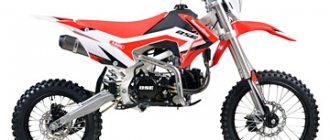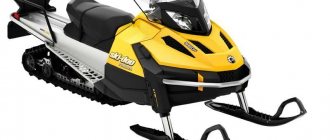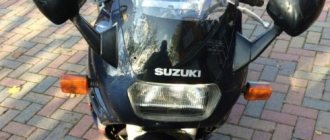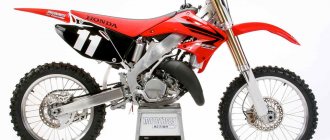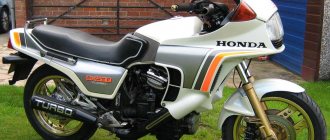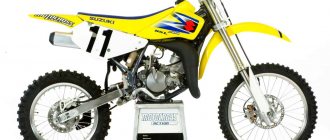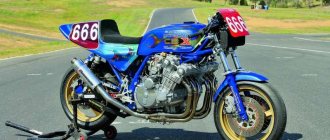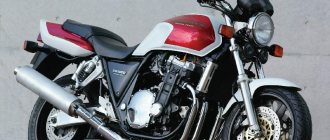Appearance
The design here is special. Like the 650, the Honda NT 700V Deville looks like a spaceship. But for other reasons. If on a smaller motorcycle this effect was achieved due to smoothness, here, on the contrary, it’s all about pretentious angularity, albeit refined. From the front, the bike resembles the face of a predatory alien creature.
The version with a high windshield has a particularly bright and daring design. Yes, it’s clear that this is a tourist, judging by the containers, dimensions and proportions, but still he is perceived somehow differently. It’s not that it’s associated with sports, but it has some kind of aggressive aesthetic. At least if the frame is silver.
Comfort
Many people like the car more than the 650 model. Some people are especially impressed by the traction at low and mid-range speeds. This is really important for a touring bike. High speeds for such equipment are, in principle, undesirable. The bike is designed for a measured ride.
Of course, it is more comfortable to ride a motorcycle equipped with ABS. The tank is large, which is convenient, but fuel consumption is not low. Therefore, you should not travel too far from gas stations. Driving such a motorcycle along the road with your hands is neither a pleasant nor an easy task. Even the dry weight of this model is significant.
Dimensions and weight
The tank is huge. However, if it were smaller, it could create problems for someone. After all, this is a touring motorcycle. The weight of two and a half centners does not prevent the model from having decent acceleration to 100 and maximum speed. And this is important even for a bike of this heavy and clumsy class.
Dimensions:
- tank - 19.7 l;
- ground clearance - 130 mm;
- curb weight – 254 kg;
- height – 1480 mm;
- width – 805 mm;
- length – 2215 mm;
- seat height – 805 mm.
Compared to a sportbike, the car is huge, as well as compared to a motocross motorcycle. As for road motorcycles, the difference is visually smaller, but in fact almost the same. Comparable classes are enduro-tourist and sport-tourist. Here the mass and dimensions will be approximately the same.
NC 700
The Honda NC 700 (NC 750) series of road motorcycles was first introduced in 2011, and mass production and sales began in 2012 in Japan, Europe, North America and Oceania. In total, 2 modifications of the Honda NC700 model were presented:
Honda NC700S – road version.
Honda NC700X – enduro-tourist version.
Both modifications are built on a single base and differ in appearance, ergonomics, overall dimensions and suspension travel.
Among the key features of the NC 700 series, first of all, it is worth highlighting the engine, which was created on the basis of a car engine from the Honda Jazz: the block was reduced to 2 cylinders, instead of the usual crankshaft, a 270° crankshaft was used. As a result, the NC700 engine turned out to be low-speed, but demonstrating excellent traction throughout the entire range and record fuel efficiency, officially declared within 3.5 liters per 100 km.
Another important feature of the NC 700 is the availability of versions with an automatic transmission (DCT - dual clutch transmission) with two clutches. These modifications are designated by the letters D in the name: NC700SD/NC750SD, NC700XD/NC750XD.
The models are also equipped with an ABS system. Such modifications have the letter A in the name: NC700SA/NC750SA, NC700XA/NC750XA. An important nuance is that the NC700 models were equipped with ABS with combined brakes (C-ABS), while subsequent versions (NC750) were equipped with a conventional ABS system, without combined brakes.
In 2014, the NC700 was updated to the NC750, increasing engine capacity by 76 cc. see (from 669 to 745), having received a double balancer shaft, a new muffler, on-board computer and other changes. Power and torque indicators have increased slightly (50 hp -> 54 hp, 61 Nm -> 68 Nm).
For 2021, the NC750 series models have been redesigned again. In addition to the changed appearance (new wheel color, new dashboard), the models receive a new muffler shape, a larger trunk, LED headlights and lights, new front suspension settings, 7-speed rear suspension adjustment and additional transmission modes in versions with an automatic transmission.
Based on the engine and chassis of the Honda NC 700 (NC 750), the Honda CTX700 and Honda NM4 Vultus models were built.
Content
The main competitors of the Honda NC700 in the class:
Kawasaki ER-6 / Kawasaki Versys 650
Suzuki SFV650 Gladius
Yamaha MT-07 / Yamaha MT-07 Tracer
Model history
2012 – start of production and sales of the Honda NC 700 series. Model: Honda NC700S /SA /SD; Honda NC700X /XA /XD (Japan, Europe, North America, Oceania). Frame number: RC61 (NC700S), RC63 (NC700X).
2013 – no significant changes. Model: Honda NC700S /SA /SD; Honda NC700X /XA /XD (Japan, Europe, North America, Oceania). Frame number: RC61 (NC700S), RC63 (NC700X).
2014 – NC700 series models are updated to NC750. The motorcycles receive a larger engine, a double balancer shaft, modified gearbox ratios, a new exhaust, a gear indicator on manual versions, an on-board computer (shows average fuel consumption, etc.), an adjustable brake lever, a new ABS system (without combined brakes) . Model: Honda NC750S /SA /SD; Honda NC750X /XA /XD (Japan, Europe, North America, Oceania). Frame number: RC70 (NC750S), RC72 (NC750X).
2015 – no significant changes. Model: Honda NC750S /SA /SD; Honda NC750X /XA /XD (Japan, Europe, North America, Oceania). Frame number: RC70 (NC750S), RC72 (NC750X).
2016 - the NC 750 series receives minor updates regarding the appearance and technical part - in particular, the models receive LED headlights and taillights, a new Showa fork with Dual-Bending technology, a new exhaust, additional riding modes for the DCT box, increased helmet storage, new colours, 7-way adjustable rear shock, new instrument panel, lighter clutch lever and changes to meet Euro 4 regulations. Model: Honda NC750S /SA /SD; Honda NC750X /XA /XD (Japan, Europe, North America, Oceania). Frame number: RC88 (NC750S), RC90 (NC750X).
2017 – no significant changes. Model: Honda NC750S /SA /SD; Honda NC750X /XA /XD (Japan, Europe, North America, Oceania). Frame number: RC88 (NC750S), RC90 (NC750X).
Specifications
In terms of its parameters, this is a solid tourist. The technical characteristics correspond to the colossal dimensions. A pair of albeit not the most impressive brake discs at the front, moderate suspension travel, and a cardan drive option. There are five speeds, like the previous model in the line, but you don’t need more.
| Rear brakes | one disc, 276 mm |
| Front brakes | two discs, 296 mm |
| Rear suspension | pendulum, 123 mm |
| Front suspension | telescopic fork, 115 mm |
| Overclocking | in 5.4 s to 100 km/h |
| Speed limit | 185 km/h |
| Torque at the limit | 66.2 Nm |
| Power to the limit | 65 hp |
| Steps in a box | five |
| Drive type | gimbal |
| Fuel consumption | 5.5 l per 100 km |
This is a reliable technique, so it is possible to buy a used one. However, it is better to buy a new motorcycle. Then it is unlikely that a situation will arise when serious problems are suddenly discovered in one place or another. Not everything is easy to detect right away, even if the biker has extensive experience in driving and choosing motorcycle equipment.
Honda Deauville was first released in 1998. It replaced the obsolete NTV650 Revere. The motorcycle received a solid plastic body kit, built-in side cases and a slightly derated engine to saturate low and medium speeds. But the base and drive to the rear wheel via a cardan shaft remained the same. To make it more suitable for its tourist purpose, the fuel tank capacity was increased to 19 liters. In this form, almost without changes, the motorcycle was produced until 2002. Then it was seriously modified for the first time. In the first models, apparently, there was a slight lack of space for luggage, so the trunks were increased in volume: the left one - from 18 to 24, and the right one - from 17 to 19.5 liters. The engine was equipped with lighter pistons and the vibrations emanating from it were reduced. At the same time, a combined brake system with three-piston calipers on the front wheel was installed for the first time on the Deauville 650. Now these improvements are already a thing of the past.
In 2006, a new model, the Deauville 700, debuted. The new motorcycle became much brighter and more dynamic than the previous one, which in narrow circles was often called “Grey Fellow” for its stingy design, which can be interpreted as “inconspicuous”. But the updated design is still not the main thing worth paying attention to in the Deauville 700. First of all, we are interested in the “filling” of the motorcycle, and then the appearance.
By changing the indices in the model name, you can notice that the engine has increased its volume. But not up to seven hundred “cubes,” but up to 680, leaving room for future upgrades. It is clear that by simply adding 33 cubic centimeters of volume it would be impossible to achieve such a colossal (almost 20%) increase in power and torque. The first figure was raised from 55 to 65 hp, and the second - from 55 to 66.2 Nm! To understand what's going on, you need to dig deeper. First of all, in the V-twin engine with a cylinder angle of 52°, the configuration of the cylinder heads and camshafts was changed. Instead of three-valve heads there are now 4-valve heads. The compression ratio increased from 9.2:1 to 10:1. But that's not all. In order to invest in the Euro-3 standards that have “hesitated” all manufacturers, the outdated carburetors were replaced by a proprietary PGM-FI fuel injection system. There were many advantages from this decision. For example, the engine’s response to movements with the throttle has improved throughout the entire speed range, plus gasoline consumption has decreased (to 6-7 liters per 100 km in the urban “jungle” and 5-6 liters on the highway, when driving at cruising speed 120-140 km/h). Despite the low degree of engine boost, the water cooling system with a large radiator gives it even greater reliability and protects it from overheating. The gearbox on the Deauville 700 is 5-speed. For those who find this number of steps small, let me remind you that high torque throughout the entire rev range will not force the driver to frequently click the gearbox in search of the optimal gear. This is not a street fighter or a sports tourer, in which the highest power and torque indicators are concentrated in a narrow “working” range. The V-shaped configuration of the Deauville 700 engine allows for confident acceleration even in the lower rev range.
Rear wheel drive by a closed cardan shaft, which does not require frequent maintenance, has long been the standard for large touring motorcycles, while the “junior” series of almost all manufacturers, including Honda, were content with a chain. Deauville has always been the exception to the rule in its class. The cardan has been present in his family since the time of the NTV650 Revere model, and since then its design has been improved more than once. If you do not forget to change the oil in the gearbox on time, you can be sure that during the entire operation of the motorcycle you will never have to look inside this unit.
The suspension and powerful steel diagonal frame of the new motorcycle have undergone slight modernization, but in general, these are the same components as on its predecessor. The engine, rigidly attached to the frame, takes on part of the load, making the chassis more rigid and capable of coping with the considerable weight of the motorcycle, which when fueled is 260 kg. The front telescopic fork with a 41 mm diameter of stays cannot even boast of pre-tensioning springs. But for a motorcycle, 2/3 of whose weight in running order and with a passenger on board falls on the rear wheel, this detail is not so important. What is more necessary here is the ability to adjust the rear monoshock. The designers made sure that this procedure did not take much time and did not require any tools. On the left side of the motorcycle, next to the passenger footrest, you can see a “thumb” that allows you to continuously adjust the shock absorber spring preload. The suspension travel (115 mm at the front and 122 mm at the rear) leaves one wanting only for smooth asphalt under the wheels of this motorcycle. Its ideal habitat will always be smooth intercity and international highways. But even in the city it will be more comfortable to drive than its older brothers. It is significantly lighter and more maneuverable than the Pan European 1300 and, even more so, the Gold Wing.
They took the brakes quite seriously and the list of optional components now includes an anti-lock braking system. Otherwise, this is a well-proven combination system in the previous Deauville, in which the rear brake pedal acts both on the rear wheel and on one piston in each of the two front calipers. When you press the front brake handle, the remaining two pistons of the three-piston front calipers are activated, plus the rear brake. The diameter of the brake discs is 296 mm at the front and 276 mm at the rear. This is quite enough to sharply reduce speed or stop. And in the case of installed ABS, this can be done not only on dry and clean asphalt, but also in more severe weather conditions.
By the way, about the conditions. If you're traveling in heavy rain, plastic fairings can protect your knees for a while. The windshield is now adjustable in height and angle, but is fixed in only two possible positions. In the “down” position, the top edge of the glass is well below your eye level, and if you raise it (by 17 cm), it becomes level with them, protecting you from rain and wind without impairing your visibility. For additional protection, the motorcycle has an optional shield that will prevent rain and splashes from under the front wheel from getting your boots wet. Another type of protection, against falls, is also present on the Deauville 700. These are two sliders located on the sides of the motorcycle, which, in the event of falling to one side, will preserve expensive plastic and no less expensive (for the owner) presentation of his pet.
For long trips, the Deauville 700 has built-in side cases with a total volume of 54 liters, an optional 45-liter branded central case, as well as two drawers for small items or gloves located on either side of the steering wheel. If this space for things seems not enough to someone, then the volume of the built-in wardrobe trunks can be increased by another 16 liters by ordering the corresponding set of side covers. Then the total luggage volume will be about 117 liters. And the anti-theft device in the form of a proprietary U-shaped lock can fit under the seat, next to the tool kit.
The list of additional equipment of the Deauville 700 is thought out to the smallest detail. In addition to what has already been described, it contains fog lights, both to illuminate the space both in front and behind, in order to better identify the motorcycle on the road. Two front spotlights are mounted near the radiator grille at a level of about 50 cm from the ground, and the rear fog lamp is located on the mudguard. When traveling in cold weather, the driver will be warmed not only by the warm air emanating through the air vents from the radiator, but also by the adjustable heated handles. A set of a radio and two speakers will delight you with music on the road, and a GPS navigator will help you plot your route and quickly get to your destination.
With such equipment, it’s not difficult to imagine why Europeans love this motorcycle so much. The short distances between their cities and countries, which can be considered very small compared to Ukraine, leave their mark on the choice of motorcycle to overcome them. In addition, using a motorcycle as the main transport when moving not only on the highway, but also around the city, few people would want to see under them a hulking hulk like the Golda, unable to quickly maneuver through narrow streets filled with traffic. The Deauville 700 as a “small tourer” is the golden mean, capable of satisfying the needs of many, including those who previously found touring motorcycles too cumbersome. For me, it is the first motorcycle that I would like to see in my garage with 100% confidence.
What do the owners say?
Judging by the reviews of the owners of this copy, it is even better than the previous one. However, some people don't like it solely because of the design. And these people can be understood, because the previous version had a less flashy appearance, smooth outlines with smoothed corners. And on this bike, almost all the exterior details make a loud statement. Not everyone will like this.
IMPORTANT! If you look at the videos and photos of this motorcycle, it may seem that it is not capable of fast movement. However, acceleration of just over five seconds is not the smallest indicator for such large equipment. And therefore you should be careful when starting.
Today, servicing this model will not be a problem. Motorcycle parts are easy to find and buy, considering how much it costs to do so. According to the description of the owners, this specimen is one of the most convenient to use among the tourist class. Excellent visibility through the mirrors, comfortable seating and everything else about this bike, just like the 650, is up to par.
The NT 700V Deauville is a nice motorcycle that performs well in action. Suitable for long trips. The main thing is to remember: if you really need a bike for traveling, including over rough terrain, you should pay attention to touring enduros. After all, tourists are simply not meant for this.
Review of the Honda NT700V Deauville motorcycle
Here he is... To be honest, I was lucky. I was chasing NT650. (But fortunately it was sold) and chance provided the good fortune to purchase the NT700V. Black, the first version of the injection Deville with a modified engine: a different camshaft, one versus two in the previous engine, and a changed camshaft angle. It feels like the engine has not changed much from the previous version. The torque has increased slightly and become smoother throughout the entire rev range. I didn’t find the expected shot under the top, but quite a few times I caught myself thinking that I could move in gears that weren’t quite appropriate for the situation. The traction on the lows and mids was amazing. The torque is very smooth with !!! 2,200!!!
Yes, there is no such sound as on 4 cylinders, but it captivates with something of its own, the rumbling of the kopeck piece at an average 4,700-6,800. In the first (after a full check of the beast for all sorts of backlashes, the presence of brakes and replacing the front tire, battery) exit into the city, I understand that at 120 km/h a feeling of “a sofa in the living room” appeared, the comfort did not let go until 160, then you can easily reach 190, but turning attention to my “not a young body”, calmness becomes a fundamental factor.
Taxiing: In traffic jams, much calmer than sport. Similar to enduro. Easy, predictable. The width of the panniers in traffic jams doesn’t bother you, if you’ve gotten over your ass with karma, you don’t worry about it anymore. So, the verdict is this: Sport is good, even very good, enduro in its own way.....but... when you become a mature, calm “backbone”, you begin to think about compromise. The desire for dynamic, extreme movement gives way to a feeling of safety and reliability. Moreover, the elements of drive and dynamics remain on this “Tourist”.
It consumes from 5 to 6 liters of 98 ben I fill. Moreover, the piloting style is always different. (Even though I’m an old man, by some standards, it’s a thrill to light things up))). The suspensions are predictable and breakable (I came out of enduro), but as I got used to them they turned out to be very comfortable. The fork is a little soft, I'll change the oil and let you know how it turned out. But the rear one: It has a very important element, which is practically presented everywhere, but in a less convenient form: remote adjustment of stiffness, which is nice when loading at the dacha, and even with the wife. I use it with pleasure.
Brakes: Combined, it’s a pity that without ABS., I liked it very much, especially after the single-disc Transalp, the efficiency of a locomotive! Once I pulled over the brakes and was cleaning my pants))). I stayed on wheels, but with an understanding of the possibilities, so when choosing, pay attention to ABS, a little more expensive, but much safer! It would be better if there was ABS.
The luggage systems are impressive, everything is the same as in the NT650, it’s convenient, together with a 46-liter trunk, there are no equals in any other class. (Golda will of course be ahead, but she is much broader). And the universality of applicability of the device is the most important thing, at least in my opinion.
The wind protection is decent despite the small size of the Burdock, and my first version has only two adjustments. In later versions (from the 10th year), (it is implemented on guides with an electric drive.) I was satisfied only in the upper position, my height is 176 cm. In the lower one, the brain and the helmet put on it ripple mercilessly.)))
Cardan shaft: The reason for parting with Transalp was the purchase of it with a defective drive sprocket, namely the lack of splines on the input shaft. It was simply welded to the shaft. Reliability was at least doubtful. A plan has matured to move away from this weak position altogether. And here it is the cardan! To be honest, it is noisy. I have it on mine at initial speeds. Remember “Ural” or “Dnepr”. This is about the same thing. Others are about the same. The oil change did not produce a significant acoustic sensation. But during operation I did not notice any deterioration. Got used to the howling.
Otherwise, I'm satisfied to the limit. To be honest, I looked at ST. But I’ll probably use it for another year.
To begin with, I’ll just briefly describe the motorcycle. It has a V-twin with ≈65 horses (too lazy to look for it). It drags well from ≈3 to 7.5 thousand, at 2-2.5 you can easily start, i.e. you don’t have to turn the engine. It purrs nicely, I really like it.
Drive - cardan (no paralever  ).
).
Some modifications are equipped with combined brakes with ABS; all with integrated side cases with a volume of 19.5 and 24 liters; you can order wide lids that will give +11 liters on each side; The center case is also for sale.
It is heavy: 248 kg of “take-off weight”, and this is without the central case. It’s unlikely to be able to impress with its dynamics - 6 seconds to a hundred. On the other hand, it’s still much more dynamic than any car. Of the suspension adjustments, there is only rear spring preload to compensate for the load. No tools needed - just turn the handle on the left.
NT700V are:
* 2008 (later modifications are almost no different from 2008) and
* earlier (2006—2008).
So, I have an early one, and its main feature is an almost non-adjustable windshield. It has two positions, and changing them takes a long time (you need to take the tool and spend 20 minutes). However, the top position suits me and I won’t change it.
In the later ones, it can be easily adjusted by hand without tools when parked (or by an electric motor, but this option was expensive, hardly everyone has it). Visually it is distinguished by two wide gutters along which wide (plastic or plastic-coated) windshield mounts ride. The old model has narrow slots there through which metal brackets stick out.
I’ve been riding it since Tuesday, I’ve already gained some impressions, but there won’t be much more: over the weekend I’ll register it and put it in storage.
I’ve been driving my Deuville 700 for the 4th season. I’m very pleased with the purchase, I couldn’t be happier with the card. 24 thousand passed, took it second hand, with a mileage of 19,000 km. I installed a lower fairing (for the legs), a large windshield from the V-Stream company, enlarged pannier covers... everything fits. everything you need for the journey. On the highway, consumption at a stable 100 km/h is 4 liters. with full load, increased drag. With high glass it is very comfortable to drive, until late autumn.
